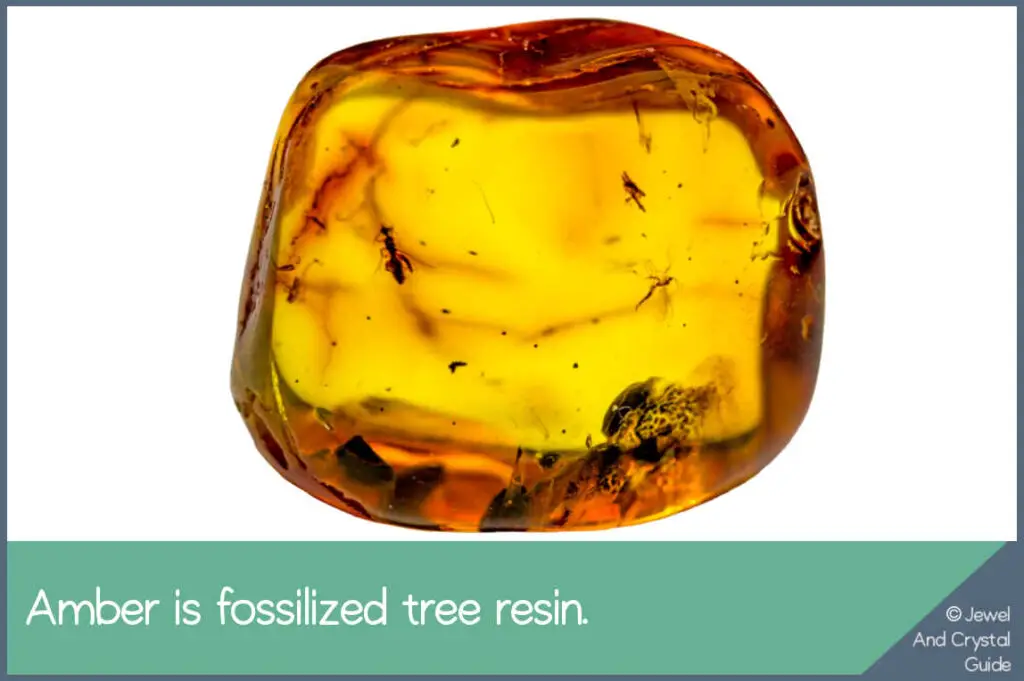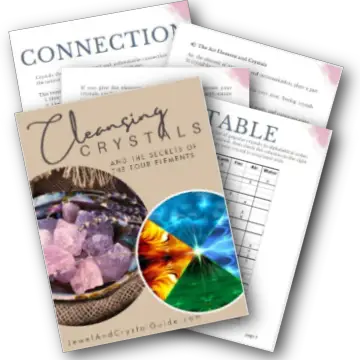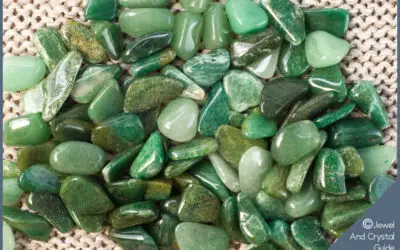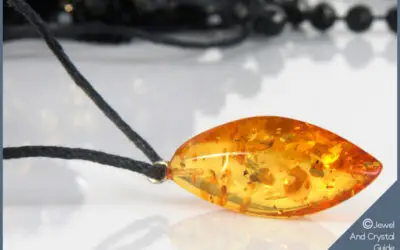Sometimes we just need to know if a piece of amber is genuine or fake.
You can tell if amber is real by seeing if it shines blue or green under UV light, has a woodsy pine smell when warmed, generates static electricity, and can be scratched by a copper penny.
In this blog post, I’ll share all the methods and tests you can use to check if amber is real or not. While no test is foolproof, doing a few of these will give you a good idea if you’re holding natural amber.
By the end of this post, you’ll have 12 ways to tell if amber is real or fake.
Test if amber is real with …
A density test
Amber has a specific gravity of 1.05 to 1.1, depending on what’s in the gem.
A fairly accurate way to tell if amber is real fossilized resin and not fake is to measure its specific gravity. Don’t be scared – I’ll show you how!
To get an object’s specific gravity, we measure how much space it takes when we drop it in water.
Here are the steps to calculate the specific gravity of a piece of amber:
- Weigh a container and write down the weight up to two decimal places. Make sure the container is large enough to hold water and the amber you are testing.
- Add water to the container and take this measurement, again with two decimal places.
- Put the amber in the water. Now write down this measurement up to two decimal places.
- Subtract the weight of the empty container from the weight of the water-filled container and the water and amber weight. You now have the true weights of the water and the water and amber together.
- Divide the true weight of the amber and water weight by the true weight of the water-only weight. This gives you the amber’s specific gravity.
If the specific gravity of the amber is around 1.05 to 1.10, it falls within the typical range for genuine amber.
However, copal, a much younger resin that’s often sold as real amber, also has a specific gravity in this range, with an average of 1.06. If copal is suspected, it’s best to do a UV light test (explained later in this blog post) or other tests to be sure you have amber and not copal.
If the specific gravity is significantly out of this range, there might be impurities in the amber or it might be a fake. It’s a good idea to perform different tests and inspections that I discuss in detail below to decide if a piece is real amber or not.
A visual inspection

Doing a visual inspection of a piece of amber is a good way to get an idea if you have a real piece of amber or a fake made from copal, plastic, or some other resin.
Authentic amber usually has a warm, rich color ranging from yellow to brownish-red. Look for natural imperfections or inclusions, and some natural amber even sparkles. Fakes often look like real amber but they’re too perfect.
Inclusions in real amber are tiny objects or materials that become trapped and preserved within the hardened resin. These inclusions can include a wide range of ancient things such as organisms, like insects, spiders, or even small vertebrates, as well as plant material, pollen grains, mineral fragments, bubbles, and other debris.
Inclusions aren’t a sure sign that a piece is real amber because copal also has inclusions in it, and some dishonest manufacturers put fake plants and insects in copal and other materials to make it look like real amber.
So, if the piece if perfect, uniform, has inclusions but they aren’t ancient or extinct, and is being offered at a “good price”, then your spidey senses need to be on high alert. Do some more tests to see what they tell you…
A static electricity test
This test works best in dry conditions, where there isn’t a lot of humidity in the air.
Rub the amber against a cloth or wool vigorously. Real amber stays dry and smooth, and builds up static electricity that attracts small pieces of paper or lint. If it does build up static electricity and picks up small papers, it’s probably genuine.
Fake amber is often made of synthetic materials that won’t create static electricity or attract small pieces of paper. Copal gets slightly sticky from the heat and doesn’t generate static electricity.
A UV light test
A UV light test is one of the best ways to tell if a piece is real amber or fake, especially if it’s copal being sold as amber.
Amber shines under UV light. This shine is called fluorescence.
To test if amber is real or fake using fluorescence, get a UV light (blacklight) – either online (like this one from Amazon) or at a hardware store.
Wait for nightfall, then turn off the lights and shine the UV light on the amber.
If it’s real amber, it’ll emit a blue or yellow-green glow.
Fake amber shouldn’t fluoresce or glow at all, unless it’s another crystal or gemstone that does fluoresce. And even then, it will probably shine a different color.
An acetone test
This test is best for raw pieces of amber so areas that lose their color can be buffed out. Polished pieces of amber will not give you reliable results.
Place a drop of acetone or acetone nail polish remover on the amber and leave it there. Acetone simply evaporates off real amber, leaving no sign of damage.
Fake amber imitations or plastics often turn sticky when they come into contact with acetone. Copal gets tacky, and it often starts dissolving when put to the acetone test more than once.
A saltwater test
Real amber floats in saltwater, but this test only works for amber on its own. This test doesn’t work for amber jewelry that’s set in precious metal, as they all sink.
To test if a piece of amber is real, dissolve a tablespoon of salt in a glass of warm water. Drop the amber into the water. If it floats, it’s real amber, and if it sinks, it’s something else.
But there is one problem with this test: copal also floats and looks a lot like amber. So this test can be used to eliminate other types of imitation amber, but even if the piece floats, more tests are needed to make a final decision on its authenticity.
A smell test
When real amber gets warm or hot, it emits a sweet, resinous smell, which smells a lot like pine or a forest. One way to tell if amber is real is to warm it in your hands or touch it with a hot needle and smell what happens.
Heat a needle or pin until it is red-hot, then carefully touch it on a part of the amber that you don’t mind damaging slightly, like inside the hole of a bead.
If it’s real amber, you might see a tiny puff of smoke as the pin or needle makes contact. Now take a long, deep sniff.
What can you smell?
Real amber smells woodsy because it comes from trees. Synthetic amber either has no smell, or smells like chemicals or burning plastic. Copal is said to smell clean, citrusy, and also quite piney. Again, if you think you might have copal in your hands, do a UV light test or an acetone test to make sure, and don’t rely on smell or any single test.
If you don’t want to burn the amber like this, rub it between your hands or fingers before smelling it. Real amber should still have a hint of wood and pine to it.
A tooth tap test
To get a better idea if amber is real, tap it against your front teeth.
Amber makes a very light plastic-like sound, while glass, carnelian, and other glassy fakes make a hard rattling sound.
A scratch test
We use the Mohs scale to determine how hard or soft something is out of 10.
Amber is a 2 or 3 out of 10 on the Mohs scale, which makes it quite soft.
This gives us one way to test if amber is real or not: If the stone can be scratched by a copper penny (3.5 on the Mohs scale, so harder) then there’s a good chance it’s amber and not plastic, glass, or a crystal.
But copal is also a 2 to 3 on the Mohs scale, so copal needs to be ruled out with a UV test or some other tests.
Is about the same price, no matter where you buy it
The cost of amber depends on the quality, color, and size of the piece, as well as how many people want to buy it and how much amber is available.
Also, there are a limited number of amber suppliers. These suppliers sell amber to retailers for about the same price, who sell them on to you and me.
Retailers must sell the amber for a certain amount to make a profit, which is more than what they paid to their supplier.
So if you find amber that’s on sale for a price that’s too good to be true (much cheaper than other sellers), there’s a chance it’s fake.
Here is a table with the average price ranges of amber per gram:
| Quality | Price Range (USD) |
| Low-grade amber | $1 – $20 per gram |
| Medium-grade amber | $20 – $100 per gram |
| High-grade amber | $100 – several hundred $ per gram |
Comes from a trustworthy seller
If you buy amber from a seller that you know you can trust, and that seller tells you the amber is real, then it probably is.
Some things you can do to make sure the seller can be trusted is:
- Do some research on the seller, to look for bad reviews or complaints that other people have made. You can also speak to others or join Facebook groups and ask for recommendations.
- Check the seller’s website to see what information they give and if they look authentic.
- Ask the seller to provide proof on where they got the amber from.
- Buy amber jewelry that is certified by the Gemological Institute of America (GIA) or the gem certification body in your country.
Can be confirmed by a professional
If you must know if a stone is real amber or not, and none of the above methods have given you a definitive answer, then ask a professional dealer, lapidist, or appraiser to take a look at the amber.
A professional will have the tools, knowledge, and experience to give you a better idea if a piece of amber is real or not.
If you still have questions about real amber, I’ve got answers right here.











